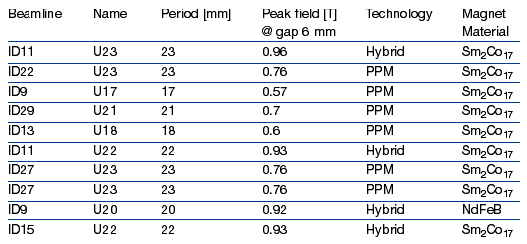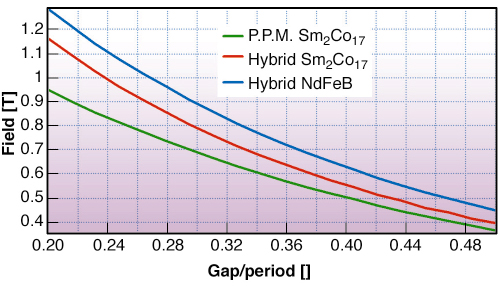- Home
- Users & Science
- Scientific Documentation
- ESRF Highlights
- ESRF Highlights 2005
- The X-ray Source
- Hybrid in-Vacuum Undulators
Hybrid in-Vacuum Undulators
The development of in-vacuum undulators started at the ESRF in 1999. In December 2005, eight devices were in user operation and two units were in preparation (Table 8).
 |
|
Table 8: Main Parameters of the in-vacuum undulators. All undulators are presently in operation except the last two devices, U20 for ID9 and U22 for ID15, which are scheduled for installation in January 2006 and July 2007. Note that both ID11 and ID27 are equipped with two in-vacuum undulator segments. |
As for any type of permanent magnet undulator, the assembly can either be based on a Pure Permanent Magnet (PPM) assembly with 4 magnet blocks per period, each block having a magnetisation rotated by 90 degrees, or can based on the Hybrid technology in which the period is constituted from two magnet blocks separated by a soft iron pole. The hybrid technology produces a higher peak field for the same magnetic gap and period. However the magnetic field corrections (field integral, integrated multipole and phase shimming) are much easier to perform with the PPM technology. The ID11 U23 mm undulator, the first in-vacuum undulator installed in 1999, was already built with the hybrid technology, but its phase errors and residual field integrals were rather poor as a result of a lack of time for the shimming process as well as a inadequate mechanical design of the magnet holders. To avoid these difficulties, subsequent in-vacuum undulators were built with the PPM technology and indeed achieved an adequate phase error around 2 degrees. Once the process of producing high field quality PPM in-vacuum undulators was mastered, the question was then reinvestigated for the ID11 U22 and the ID9 U20 for which it was decided to return to the hybrid technology in order to boost the peak field. The rms phase error reached 2.5 degrees for the U22. The phase error of the U20 is 4 degrees but was not corrected since being used on the fundamental or third harmonics it was considered as adequate. Another important modification was introduced in the newly built ID9 U20, namely the replacement of the Sm2Co17 magnet material (originally selected for its high resistance to radiation damage) by a special grade of NdFeB magnet with high coercivity. The question of radiation damage is a sensitive issue for in-vacuum undulators, which aim at the smallest gap possible and constitute the places in the ring circumference where the electrons are most likely to be lost. The showers produced by electrons in the magnetic material results in a partial demagnetisation. The risk of using NdFeB material for the ID9 U20 was accepted considering that such an undulator is only used on harmonics one and three. Figure 165 presents the peak field vs the ratio of gap over period. These curves clearly show a 30% field increase reached by the hybrid NdFeB compared to the PPM Sm2Co17 for a 6 mm gap undulator with a 20 mm period.
 |
|
Fig. 165: Peak field versus the ratio of gap/period for three different type of in-vacuum undulators. The ones with the best performance are indeed the hybrid undulators made of NdFeB material but they are also the most sensitive to radiation damage. |



